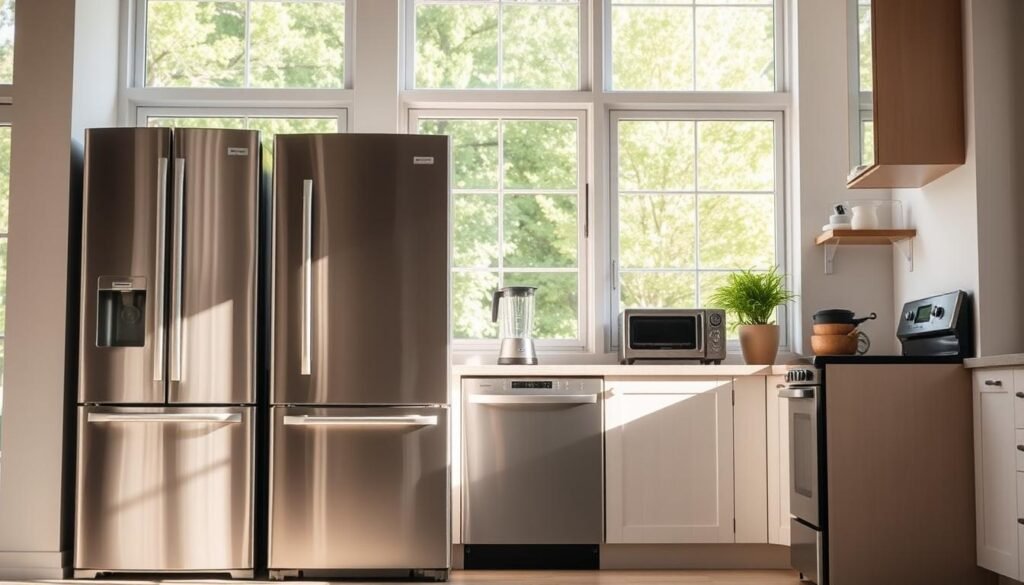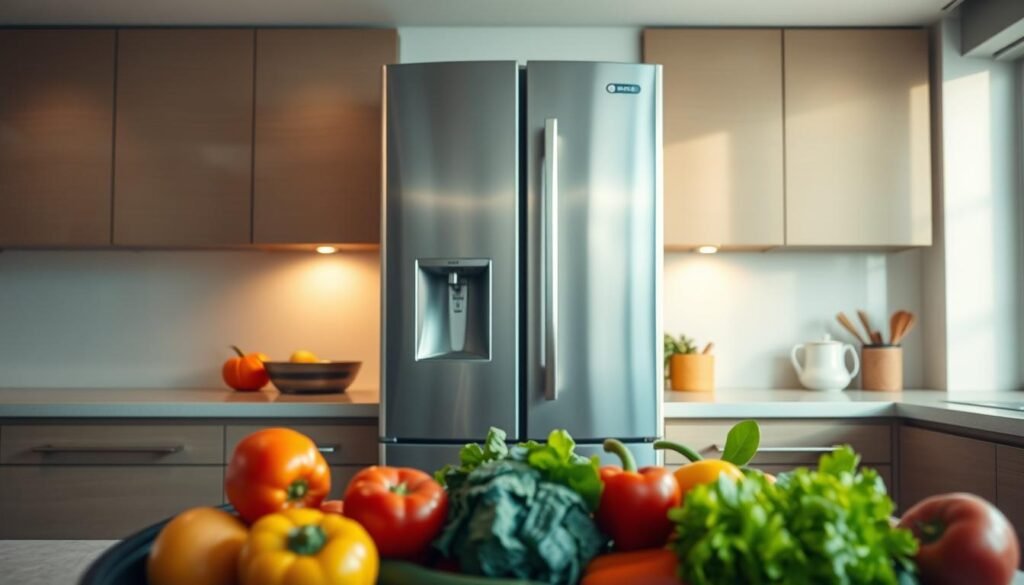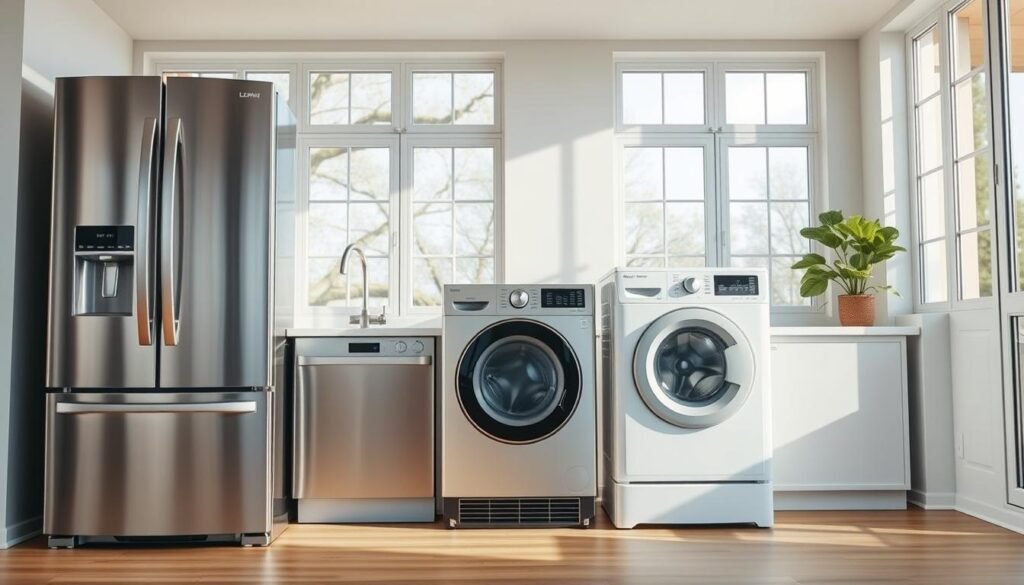Welcome to your guide to smarter living! Choosing the right equipment for your house can make a big difference in your monthly bills and environmental footprint.
Did you know you could save up to $400 per year on utility costs? That’s real money staying in your pocket instead of going to energy expenses.
Better efficiency doesn’t just mean personal savings. It contributes to larger conservation efforts that help your community and our planet.
We’ll show you how to identify top-performing products through certifications like ENERGY STAR. You’ll learn which categories offer the biggest impact on your consumption.
Get ready to discover practical tips that extend product life while maximizing performance. Small changes in usage habits lead to significant long-term savings.
Key Takeaways
- Smart appliance choices can save households hundreds of dollars annually on energy costs
- Energy efficiency contributes to both personal savings and environmental sustainability
- Proper selection reduces electricity demand equivalent to multiple power plants
- ENERGY STAR certifications help identify the most efficient products
- Regular maintenance extends appliance life while maintaining peak performance
- Usage habit adjustments create substantial long-term financial benefits
- Energy-efficient investments benefit both your wallet and your community
Why Energy-Efficient Home Appliances Save You Money and Energy
Your household machines quietly shape your monthly expenses more than you might realize. The typical American family spends about $2,200 per year on power costs. About 20% of that total goes directly to running your equipment.
That refrigerator humming in your kitchen? It accounts for roughly 13% of your annual utility bill. Your dishwasher, washer, and dryer add significant costs too.

Modern high-performance models slash these expenses dramatically. They use less electricity and water while delivering superior results. This means lower operating costs throughout their entire lifespan.
The initial investment often pays for itself through ongoing energy savings. Many families see a return on their purchase within just a few years.
Here’s how these smart choices benefit you:
- Reduced monthly utility bills that put real money back in your pocket
- Lower environmental impact through decreased power plant emissions
- Advanced features that work better while consuming fewer resources
- Potential rebates from utility companies that make upgrades more affordable
Proper maintenance and smart usage habits can double your energy savings. Simple adjustments like running full loads or optimizing temperature settings make a big difference.
Reducing your energy consumption also helps your community. It decreases strain on power grids during peak demand times. This contributes to more stable electricity services for everyone.
Your choices create a ripple effect of positive change. You save money while supporting broader environmental goals. It’s a win-win situation that starts in your own living space.
Ready to discover how to identify these top-performing products? The next section will show you how to spot the best models using official certifications.
How to Spot the Most Efficient Models: Understanding ENERGY STAR and EnergyGuide
Decoding appliance labels is your secret weapon for making wise purchasing decisions. Two key systems help you identify top-performing equipment that saves money and resources.
These certification programs provide clear, standardized information about how much electricity different models consume. Understanding them transforms confusing technical specs into actionable shopping guidance.
What the ENERGY STAR Logo Really Means
When you see the blue ENERGY STAR logo, you’re looking at a product that meets rigorous government standards. This certification represents a joint program between the U.S. Environmental Protection Agency and Department of Energy.
Manufacturers must demonstrate their products meet or exceed strict energy-efficiency guidelines. The testing process ensures superior performance without compromising on features or functionality.
Appliances with this certification typically use 10-50% less energy than standard models. This translates directly to lower operating costs throughout the product’s lifespan.
The ENERGY STAR program covers multiple categories including refrigerators, washers, and cooling systems. Some products even earn the “Most Efficient” designation for cutting-edge innovations.
Decoding the EnergyGuide Label
The bright yellow EnergyGuide label provides instant comparison data right at the point of purchase. Developed by the Federal Trade Commission, this mandatory tag helps you evaluate different models side-by-side.
You’ll find estimated yearly operating costs and energy consumption information. The label shows where a particular model falls within the efficiency range of similar products.
This allows you to quickly identify which options will use less energy and save you money. The comparison scale makes it easy to spot top performers without technical knowledge.
Remember: while EnergyGuide labels are required on most appliances, ENERGY STAR certification is voluntary. Products can have both, giving you double confirmation of their efficiency credentials.
“The EnergyGuide label empowers consumers to make informed choices based on actual energy use data.”
Mastering these two systems puts you in control of your purchasing decisions. You’ll confidently identify equipment that delivers performance while minimizing energy use.
Top Energy-Efficient Appliances for Your Home
Now let’s explore specific equipment categories that deliver outstanding performance while cutting your utility bills. Each type offers unique opportunities for savings.
You’ll discover which features matter most and which designs work best. This knowledge helps you make informed choices for your household.

Refrigerators and Freezers
Your cooling units run 24/7, making efficiency crucial. The most effective models typically measure 16-20 cubic feet.
Top-freezer and bottom-freezer designs outperform side-by-side configurations. They maintain temperature more consistently.
Extra features like ice makers and water dispensers increase energy use. Simpler models often provide better long-term value.
Proper sizing matters too. A unit that’s too large wastes energy cooling empty space.
Clothes Washers and Dryers
Modern front-loading machines revolutionize laundry day. They use significantly less water than traditional top-loading models.
These advanced units handle larger loads while consuming fewer resources. You save on both water and heating costs.
When selecting a dryer, look for moisture sensors. They automatically shut off when clothes are dry, preventing energy waste.
Matching your washer and dryer capacity ensures optimal performance. This coordination maximizes efficiency with every load.
Dishwashers
Today’s dishwashers clean brilliantly while using minimal resources. Energy-saving cycles provide sparkling results with less water and electricity.
Look for models with soil sensors. They adjust wash intensity based on how dirty your dishes are.
Delay start features let you run cycles during off-peak hours. This can further reduce your energy costs.
Proper loading techniques also improve efficiency. Full loads work best, but avoid overcrowding.
Water Heaters
Tankless models represent a breakthrough in hot water technology. They heat water on demand rather than maintaining a stored supply.
This approach can reduce your water heating costs by up to 50%. You enjoy endless hot water without standby energy losses.
These compact units save valuable space too. Their streamlined design fits neatly in utility areas.
Professional installation ensures optimal performance. Proper sizing matches your household’s hot water needs.
Air Conditioners and Heating Systems
Cooling and heating account for major energy expenses. Selecting the right equipment makes a substantial difference.
Look for air conditioners with an Energy Efficiency Ratio of 10.0 or higher. This rating indicates superior performance.
Proper sizing prevents short cycling and energy waste. An oversized unit cools too quickly without removing humidity.
Regular maintenance keeps systems running efficiently. Clean filters and coils ensure peak performance year-round.
Each category offers specific features that maximize savings. Understanding these options helps you choose the perfect products for your needs.
Smart Usage and Maintenance Tips to Maximize Your Savings
Your smart choices don’t end at the store. How you use and care for your equipment makes a huge difference in ongoing savings. These practical strategies help you get the most from every dollar spent.
Simple adjustments to your daily routines can slash your utility bills even further. You’ll enjoy better performance while reducing your environmental impact.
Refrigerator Efficiency Tricks
Your refrigerator works constantly, making small adjustments very valuable. Set your fridge between 34-40°F and freezer between 0-5°F for optimal performance.
Seasonal temperature changes affect how hard your unit works. Adjust settings slightly during extreme weather to maintain efficiency.
Vacuum the condenser coils twice yearly. This simple task prevents dust buildup that forces your refrigerator to work harder.
Keep your unit well-stocked but not overcrowded. Proper air circulation helps maintain consistent temperatures throughout.
Laundry Best Practices
Your washing habits significantly impact energy and water use. Match water levels to load size—most energy goes toward heating water.
Cold water rinses work perfectly for most clothes. They clean effectively while reducing energy consumption dramatically.
Clean your dryer’s lint screen after every load. This simple habit improves airflow and reduces drying time significantly.
Full loads maximize efficiency, but avoid overstuffing. Your washer needs space to clean clothes properly.
Dishwasher Dos and Don’ts
Modern dishwashers handle heavily soiled items without pre-rinsing. Simply scrape food scraps instead of pre-washing to save water.
Always wait until you have a full load before running your dishwasher. Partial loads waste both water and energy.
Use energy-saving cycles for everyday cleaning. These programs provide excellent results while minimizing resource use.
Regular maintenance prevents clogs and ensures peak performance. Check filters monthly and clean them as needed.
Heating and Cooling Optimization
Your climate control systems benefit greatly from proper care. Clean or replace air conditioner filters monthly during peak usage seasons.
Maintain 18 inches of clearance around outdoor condenser units. Proper airflow ensures efficient operation and prevents overheating.
Insulate your water heater and set temperatures between 120-140°F. This reduces standby heat loss and prevents scalding risks.
Schedule professional maintenance annually for optimal performance. Technicians can identify issues before they become major problems.
These practical tips help you maximize savings from your efficient products. Consistent maintenance and smart usage habits compound your financial benefits over time.
Conclusion: Making the Switch to Energy Efficiency
Your journey toward smarter energy choices begins with understanding total costs. Look beyond the purchase price to include operating expenses and maintenance needs.
Check with your local utility company for available rebates. The ENERGY STAR program offers special offers that make upgrades more affordable.
Proper disposal of old units through recycling programs protects our environment. This responsible approach completes your efficiency upgrade cycle.
These changes create significant savings on your monthly bills. You’ll enjoy better performance while reducing your environmental impact.
Start with your highest-usage products for maximum benefit. Each upgrade contributes to cumulative financial and ecological rewards.
Your new energy-efficient appliances represent smart investments that pay back over time. They deliver comfort while keeping more money in your pocket.


